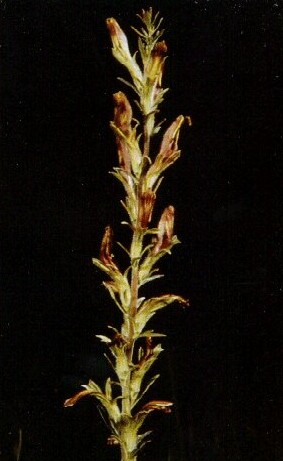American chaffseed facts for kids
Quick facts for kids American chaffseed |
|
|---|---|
 |
|
| Conservation status | |
| Scientific classification | |
| Genus: |
Schwalbea
|
| Species: |
americana
|
The Schwalbea americana, also known as American chaffseed, is a very special and rare plant. It is the only type of plant in its group, called Schwalbea. This plant is a tall, green herb that lives for many years. It is also a hemiparasite, which means it gets some of its food from other plants, like a friendly neighbor sharing snacks! You can find it in the southeastern United States, usually in wet, grassy areas with acidic soil.
Sadly, this plant has become very rare. It has disappeared from many places where it used to grow. This happened mostly because of changes in how land is managed, especially stopping natural fires. Because it is so rare, the U.S. Fish and Wildlife Service lists it as "Endangered."
Contents
What it Looks Like
This plant is an herb that grows about 1 to 2.6 feet (0.3 to 0.8 meters) tall. It has pretty flowers that bloom from April to June. Bees help to pollinate these flowers. After flowering, the plant makes fruits from July to September.
The fruit is a dry, brown capsule, shaped like a narrow oval, about 0.4 inches (1 cm) long. Inside, there are many flat, winged seeds. These seeds are likely spread by the wind, but usually not very far from the parent plant.
How it Lives
Even though the American chaffseed is a hemiparasite, it is not picky about its hosts. This means it can get food from many different trees, bushes, and other herbs. It connects to the roots of these other plants to get some of its nutrients.
Fires are super important for this plant to survive for a long time. Fires help the seeds to sprout and grow. After a fire, the ground is clear, and the tiny seeds can grow in the soil with lots of sunlight. The plant's tough seed capsule protects the seeds from the heat of the fire. In fact, the heat might even help the seeds to sprout better!
Plant History
The American chaffseed, Schwalbea americana, was first described by a famous scientist named Carl Linnaeus in 1753. It is still considered the only species in its group. Another plant, Schwalbea australis, was once thought to be a different species, but scientists now agree it is the same as Schwalbea americana.
Where it Grows
American chaffseed usually grows in sandy, acidic soils that can be wet or dry at different times of the year. It likes open areas such as moist pine forests, grassy savannas with pine trees, and places where wet areas meet dry, sandy soils.
Historically, these habitats were kept open and healthy by natural wildfires or fires started by people. These pine savanna areas are known for having many different kinds of plants.
Saving the Plant
The American chaffseed was officially listed as a Federally Endangered plant on September 29, 1992. This means it is at high risk of disappearing forever.
In the past, this plant grew in many states, from Kentucky and Tennessee to 15 states along the eastern and southeastern coasts. However, it hasn't been seen in Kentucky and Tennessee since the 1930s. Now, it is only found in five coastal states: Florida, Georgia, North Carolina, South Carolina, and New Jersey. Recently, it was even found again in Massachusetts after being thought lost for 50 years!
Today, scientists have found 71 groups of these plants still alive. But most of these groups are small, with only a few plants. In North Carolina, 17 out of 18 known groups are found on Fort Bragg. These areas at Fort Bragg have frequent fires, which helps the American chaffseed to grow well. Fort Bragg is one of the most important places for this plant, along with eastern South Carolina and parts of Georgia and Florida.
Even in places with fewer competing plants, American chaffseed numbers drop if there are no frequent fires. This shows how much fires are needed for this plant to survive.
Recovery Plan
A plan to help the American chaffseed recover was started on September 29, 1995. This plan was created by the U.S. Fish and Wildlife Service and the U.S. Department of the Interior.
The American chaffseed will be considered less endangered when:
- At least 50 healthy plant sites are protected forever across its current range.
- Four of these 50 sites are in the northern part of its range (from Massachusetts to Virginia).
- Plans are in place to manage all 50 protected sites.
- Scientists understand enough about the plant's life and needs to know if the groups are healthy.
- Monitoring every two years shows that the 50 sites are healthy for 10 years.
Images for kids



